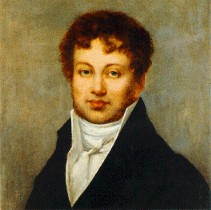André Marie Ampère (1775 - 1836)
André-Marie Ampère was born born on 20 Jan 1775 in Lyon, France. It has been claimed that Ampère had mastered all known mathematics by the age of twelve years but this seems somewhat of an exaggeration since, by Ampère's own account, he did not start to read elementary mathematics books until he was 13 years old.
After taking a few lessons in the differential and integral calculus from a monk in Lyon, Ampère began to study works by Euler and Bernoulli. He then acquired a copy of the 1788 edition of Lagrange's Mécanique analytique and began serious study of the work. However his life was soon to be shattered. The French Revolution began with the storming of the Bastille on 14 July 1789 but the effect on the Poleymieux region was not very great at first. Ampère's father kept out of trouble until late in 1791 when he accepted the position of Justice of the Peace in Lyon.

The city of Lyon refused to carry out instructions from Paris and the city was besieged for two months. On the fall of the city Ampère's father was arrested for issuing an arrest warrant for the Jacobin Chevalier who had then been put to death. While Ampère moved to Bourg where he taught physics and chemistry but his research was in mathematics. This research resulted in him composing a treatise on probability, The Mathematical Theory of Games, which he submitted to the Paris Academy in 1803. Laplace noticed an error, explaining the error to Ampère in a letter, which Ampère was able to correct and the treatise was reprinted.
Appointed professor of mathematics at the Ecole Polytechnique in 1809 he held posts there until 1828. Ampère was appointed to a chair at Université de France in 1826 which he held until his death. In Paris Ampère worked on a wide variety of topics. Although a mathematics professor, his interests included, in addition to mathematics, metaphysics, physics and chemistry. In mathematics he worked on partial differential equations, producing a classification which he presented to the Institut National des Sciences in 1814 to which he was admitted November of the same year.
Ampère and corrosion monitoring
Ampère was also making significant contributions to chemistry. In 1811 he suggested that an anhydrous acid prepared two years earlier was a compound of hydrogen with an unknown element, analogous to chlorine, for which he suggested the name fluorine. Ampère also worked on the theory of light, publishing on refraction of light in 1815. By 1816 he was a strong advocate of a wave theory of light, agreeing with Fresnel and opposed to Biot and Laplace who advocated a corpuscular theory. In the early 1820's, Ampère attempted to give a combined theory of electricity and magnetism after hearing about experimental results by the Danish physicist Hans Christian Orsted. Ampère formulated a circuit force law and treated magnetism by postulating small closed circuits inside the magnetized substance.
Another scientist working on magnetism at this time was Poisson who insisted on treating magnetism without any reference to electricity. Poisson had already written two important memoirs on electricity and he published two on magnetism in 1826.
Ampère's most important publication on electricity and magnetism was also published in 1826. Ampère's theory became fundamental for 19th century developments in electricity and magnetism. Faraday discovered electromagnetic induction in 1831 and, after initially believing that he had himself discovered the effect in 1822, Ampère agreed that full credit for the discovery should go to Faraday. Weber also developed Ampère's ideas as did Thomson and Maxwell.
In 1826 Ampère began to teach at the Collège de France. He was there in a position to teach courses of his own instead of topics set for him as was the case at Ecole Polytechnique. Ampère thus taught electrodynamics and this course was taken by Liouville in 1826-27. Liouville made an important contribution to Ampère's electrodynamics course by editing a set of notes taken from Ampère's lectures.

Connect with us
Contact us today